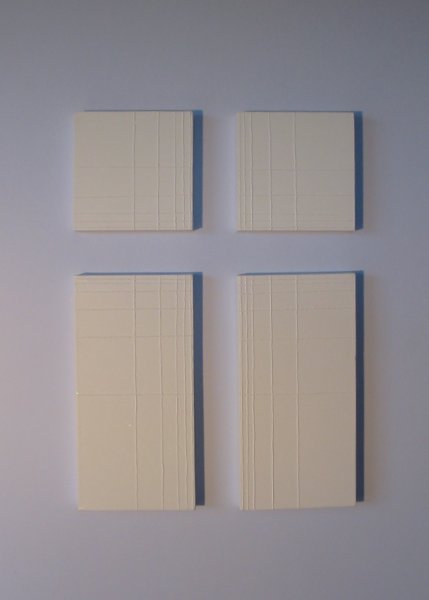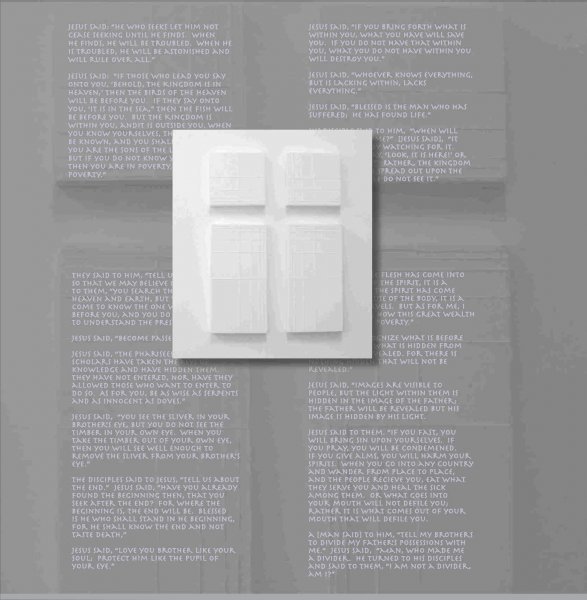acrylic and invisible ink on 4 canvases, 655 x 465 mm (26″ x 18 1/2″) combined.
The words in this work are hidden. Literally. This piece looks at the age-old debate between those who want the truth substantiated and those who have faith. It uses minimalism to begin an exploration of the game we play with “the other.” Bearing in mind that “the other” includes our other ‘selves’, we desire to keep things secret and hidden in an effort to convince ‘the other’ that what we believe is “the truth.’ Conversely, if we think someone is keeping something from us, we become curious and want to find out what it is.
For this piece I have chosen a significant secret in western civilization: Words that were hidden for centuries, having been written down at the beginning of one of the most significant movements of mankind, a record of the sayings of one of the most influential people in history — words that were thereafter ordered destroyed by those who made that person known to the world.
The words are said to be those of Jesus Christ, as set forth in the Secret Gospel of Thomas. They were found in a cache of papyrus texts from the first and second century b.c., that was unearthed in 1945 by a goat herder in the deserts of Upper Egypt near Nag Hammadi. The Thomas Gospel is comprised of 114 sayings attributed to Jesus. The early Church dismissed the Gospel of Thomas when deciding what belonged in the New Testament, declaring it heretical and ordering it destroyed.
What was it that Thomas attributes to Jesus that the early founders of Christianity didn’t want to include?
The composition of my work is set around negative space. The idea is that a symbol is a construct of that which surrounds it. What exists in the space around it is reduced to words, giving it meaning. We read into the symbol our interpretation of what exists in the surrounding space and it becomes our reality, even when the contents of that space changes.
At first glance, this work appears to the viewer as Minimalist Art. The white on white could be seen as an aesthetic structure based on a mathematical formula. However, if the viewer includes the negative space between the four canvases, he will perceive a Cross. This discovery could put the viewer off, thinking it belongs in a church rather than an art gallery, and he may never discover the hidden words that cast doubt on the teachings of the Church.
The gospels of Mathew, Mark, John and Luke, included in The New Testament, are the cornerstones of Christianity, and are represented in this piece by the four canvases. But the hidden words written on the canvases are not from the New Testament. They are from the secret Gospel of Thomas, and are written in invisible ink. The viewer must become engaged in the work and follow the clues to find them. The clues are intentionally scant. The work uses the grid to symbolically represent bars: the words in the work have been hidden from us, locked away by others. They are written in invisible ink to signify that, not only have they been hidden from us, but that they were deemed to be secret words. Not everyone will find them. Not everyone will want to find them.
The bars also represent our own captivity, or security… created by our culture, convictions, beliefs, habits, and fear. Much like in Plato’s allegory of the Cave, we are accustomed to viewing our world through these beliefs and convictions and become disturbed at the thought of living in a world without them.
Each bar divides the space it is in, in half (representative the duality of the debate). The nearer they are to the symbol of the Cross, the closer together they become, indicating that the invisible words may threaten some of our beliefs.


